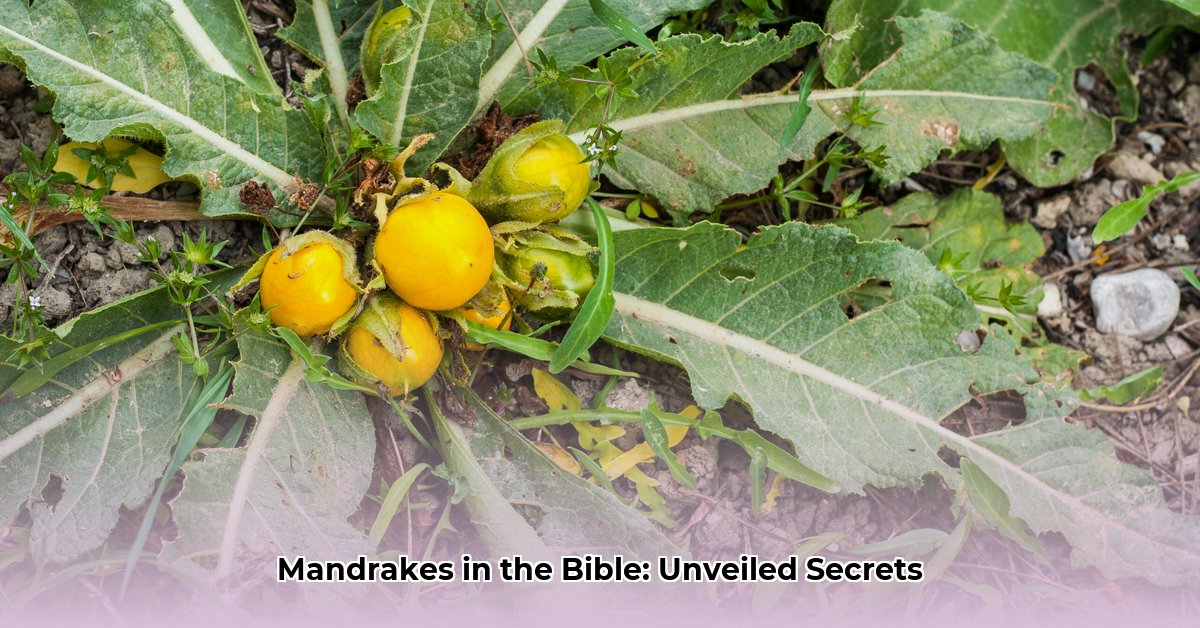Ever heard of a plant so powerful it was linked to fertility and even magic in the Bible? That’s the mandrake, a plant with a strangely human-shaped root that appears in both the Genesis and Song of Solomon stories. For centuries, it’s been shrouded in mystery and myth, sparking questions: What exactly was this plant? Were the ancient beliefs about its powers real, or just tall tales? This article digs into the fascinating history of mandrakes in the Bible, exploring their botanical aspects, their role in ancient cultures, and how they’ve been interpreted over the years. We’ll sort fact from fiction and unravel the symbolism woven into these biblical narratives. For more on ancient scents, check out this article on frankincense.
What are Mandrakes in the Bible?
The Bible mentions a plant called dudaim, often translated as “mandrakes.” These aren’t just ordinary plants; they’re wrapped up in stories that tell us about life in ancient times. Let’s delve into the world of biblical mandrakes and uncover their secrets.
Rachel’s Bargain: Mandrakes and the Yearning for Children
In the book of Genesis (Genesis 30:14-16), we meet Rachel, a woman yearning for children. Childless, she makes a deal with her sister Leah: Rachel will give Leah a night with her husband Jacob in exchange for some dudaim. This scene paints a picture of the intense societal pressure and personal longing for children in ancient societies. Imagine the heartache Rachel must have felt, the desperation driving her to such a bargain. The dudaim became a symbol of hope, a potential key to unlocking motherhood. It highlights the powerful desire for offspring in ancient cultures. The emphasis was not just on having children but also on having sons, who were crucial for continuing the family lineage. For Rachel, the mandrakes represented a powerful catalyst to achieving that deeply held desire.
Love’s Sweet Scent: Mandrakes and Passion in Song of Solomon
Centuries later, in the Song of Solomon (7:13), a book filled with passionate imagery and romantic longing, dudaim appear again, but their meaning shifts. The plants are now linked to the aroma of love and physical intimacy. “The mandrakes send out their fragrance, and at our door is every delicacy, both new and old, that I have stored up for you, my beloved.” It’s a contrast to the Genesis story, emphasizing the plant’s symbolism. In this context, the mandrakes represent the intoxicating allure of love and the intense physical desire between lovers. This duality shows how deeply ingrained the plant was in various aspects of life.
Unraveling the Mystery: What Plant Were They, Really?
So, what exactly were these dudaim? While most translations use “mandrakes,” the precise botanical identification is debated among scholars. The Mandragora officinarum plant, a member of the nightshade family, is the most accepted theory. These plants have roots that often resemble a human form, fueling the myths and legends surrounding them. This unusual shape contributed to the belief in their magical or medicinal properties.
The Mandragora, native to the Mediterranean region, possesses large, coarse leaves and produces small, bell-shaped flowers followed by yellow or orange berries. All parts of the plant contain alkaloids, which can have psychoactive and medicinal effects.
Mandrakes in Ancient Beliefs: More Than Just Plants
Beyond the biblical context, mandrakes held a place in ancient Near Eastern cultures. They were believed to have magical powers, from boosting fertility to acting as aphrodisiacs. People associated them with love, desire, fertility, magic, and protection. Some saw them as potent magical items, others as remedies for pain or illness. These beliefs were grounded in a worldview that saw a connection between the natural world and the spiritual realm.
Ancient writings are filled with tales of mandrakes’ purported powers. Some claimed they could ease cramps or other aches. Others saw them as a way to enhance virility. It’s a testament to the plant’s presence in folklore and mythology.
Science vs. Tradition: A Modern Perspective
Modern science hasn’t fully validated the ancient claims. We now know that mandrakes contain tropane alkaloids, substances with pharmacological effects. In large doses, these alkaloids can cause hallucinations, delirium, and even death. But the scientific evidence for their fertility-enhancing or aphrodisiac properties is weak. Many of the effects attributed to mandrakes likely stem from the placebo effect, as well as other cultural and psychological factors.
The contrast between ancient beliefs and modern science provides an example of how our understanding of the world evolves. Sometimes, what our ancestors believed isn’t confirmed by scientific findings. That doesn’t diminish the significance of ancient beliefs, but it shows us the evolution of understanding. The myths around the mandrake highlight the power of human hope and the quest for solutions to life’s desires and challenges.
Interpretations and Ongoing Debates
Scholarly interpretations of the biblical references to dudaim are varied. Some experts believe that the text should be interpreted figuratively, emphasizing the symbolic meaning—a representation of intense longing for children and love. The literal plant identification as mandrake remains a topic of ongoing research and discussion. It’s an area of study, revealing the complexities of interpreting ancient texts within their historical and cultural contexts.
The Enduring Legacy of the Mandrake
The story of the mandrake in the Bible is not just a botanical puzzle; it’s a window into the hopes, fears, and desires of ancient people. Their beliefs about the dudaim mirror our quest for connection, family, and fulfillment. The mandrake serves as a reminder of the power of belief, the role of plants in healing and spirituality, and the interplay between human history, faith, and the natural world. The mystery of the dudaim continues to fascinate and challenge us, prompting further exploration as our understanding of the past evolves.
How Did Ancient Cultures Use Mandrakes for Fertility?
Key Takeaways:
- The Bible’s depiction of mandrakes reflects ancient Near Eastern beliefs about their fertility-boosting properties.
- Biblical accounts showcase the intense desire for children in patriarchal societies.
- The mandrake’s symbolism highlights the tension between human actions and divine providence in matters of reproduction.
- Different interpretations exist regarding the mandrake’s efficacy and the biblical authors’ stance on these beliefs.
- Understanding the cultural context enriches our grasp of biblical narratives.
Mandrakes in Genesis: A Family’s Struggle
Let’s delve into the story of Rachel and Leah in Genesis 30. Their rivalry for their husband Jacob’s affection is intense. Leah, having borne several children, observes Rachel’s barrenness with pity and triumph. This reflects the societal pressure on women in ancient societies to bear children—their worth often directly linked to their fertility. The text reveals that mandrakes were valued due to a belief in their ability to enhance fertility. Leah’s son Reuben finds mandrakes, and this becomes a pivotal moment. Leah strategically uses these plants to secure a night with Jacob, hoping to conceive. The narrative underscores the human desire for offspring. Does this mean the Bible endorses these beliefs? Not necessarily. The story highlights the lengths people went to achieve something they craved yet held little control over.
Song of Solomon: A Different Perspective
Fast forward to the Song of Solomon, a book brimming with sensual imagery and romantic longing. Here, the mandrake’s association with fertility takes on a different hue. The plant’s fragrance is described as a symbol of romantic desire, lust, and the longing for physical union. This demonstrates how versatile the mandrake’s symbolism was. It represented the desperation for offspring in a familial context and the yearning for love and intimacy. The contrast is fascinating, showcasing the adaptability of cultural symbols to diverse situations.
Botanical and Cultural Understanding
The plant itself, Mandragora officinarum, is recognizable by its large leaves and its root—often forking into shapes resembling the human form. This human-like shape played a part in its association with fertility and reproduction. Ancient cultures believed the plant possessed magical properties, connecting it to supernatural forces governing birth and procreation. This belief wasn’t unique to the Near East; similar associations exist in the folklore of other civilizations. However, the exact reasons behind this belief remain unclear. Were these beliefs based on true observed effects or superstitious? The answer likely lies somewhere in between—a mixture of perceived effects, folklore, and possibly even a placebo effect.
Pliny the Elder, a Roman author, naturalist, and natural philosopher, wrote about the mandrake in his encyclopedic “Natural History,” detailing its supposed medicinal and magical properties. He described methods for safely harvesting the root, emphasizing the dangers associated with the plant due to its toxicity and the belief that it would scream when uprooted, driving people mad.
Interpreting the Texts: Ambiguity and Debate
How should we interpret the biblical mentions of mandrakes? One view is that the biblical authors simply reflect the cultural beliefs of their time, without endorsing the efficacy of mandrakes as fertility aids. Another perspective suggests a more nuanced approach— acknowledging the cultural context while also emphasizing the limitations of human effort and the reliance on divine intervention in matters of procreation. Ultimately, the Bible’s presentation of mandrakes encourages reflection on the human longing for offspring, the complexities of human relationships, and the sovereignty of God over life and reproduction.
Mandrake Symbolism in the Ancient Near East
- Water Mill Electricity Generator Provides Free Home Power - December 16, 2025
- Water Wheel Electric Generator Provides Free Home Electricity - December 15, 2025
- Choosing the Right Portable Hydro Turbine for Your Needs - December 14, 2025
















